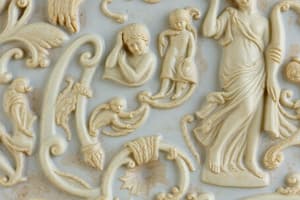Podcast
Questions and Answers
Which mechanism allows for stress amplification in ceramics?
Which mechanism allows for stress amplification in ceramics?
- Plastic deformation
- Elastic deformation
- Viscous flow
- Brittle fracture (correct)
Ceramics generally exhibit plastic deformation before fracture occurs.
Ceramics generally exhibit plastic deformation before fracture occurs.
False (B)
What phenomenon occurs when non-crystalline ceramics undergo plastic deformation?
What phenomenon occurs when non-crystalline ceramics undergo plastic deformation?
- Slipping of dislocations
- Transverse bending
- Viscous flow (correct)
- Converging cracks
What does the term 'fracture toughness' refer to in ceramics?
What does the term 'fracture toughness' refer to in ceramics?
The viscosity of a non-crystalline ceramic increases as temperature increases.
The viscosity of a non-crystalline ceramic increases as temperature increases.
Ceramics demonstrate higher strengths in _____ than in tension.
Ceramics demonstrate higher strengths in _____ than in tension.
Match the following ceramic properties with their definitions:
Match the following ceramic properties with their definitions:
What is the relationship between porosity and the modulus of elasticity in ceramics?
What is the relationship between porosity and the modulus of elasticity in ceramics?
Creep deformation in ceramics occurs as a result of exposure to __________ at elevated temperatures.
Creep deformation in ceramics occurs as a result of exposure to __________ at elevated temperatures.
Which type of fracture occurs along the grain boundaries in ceramics?
Which type of fracture occurs along the grain boundaries in ceramics?
Match the hardness measurement technique to their descriptions:
Match the hardness measurement technique to their descriptions:
Cracks in crystalline ceramics always propagate through grains.
Cracks in crystalline ceramics always propagate through grains.
What is the primary reason for ceramics' hardness and brittleness?
What is the primary reason for ceramics' hardness and brittleness?
How do very small flaws affect ceramics under tensile stress?
How do very small flaws affect ceramics under tensile stress?
When a crack's stress intensity factor exceeds _____, crack propagation can occur.
When a crack's stress intensity factor exceeds _____, crack propagation can occur.
Porosity has a beneficial influence on the elastic properties of ceramics.
Porosity has a beneficial influence on the elastic properties of ceramics.
What is the effect of 10 vol% porosity on the flexural strength of ceramics?
What is the effect of 10 vol% porosity on the flexural strength of ceramics?
Match the types of ceramic deformation with their respective behaviors:
Match the types of ceramic deformation with their respective behaviors:
What is the effect of thermal tempering on ceramic materials?
What is the effect of thermal tempering on ceramic materials?
The mechanism by which crystalline ceramics deform involves the motion of __________.
The mechanism by which crystalline ceramics deform involves the motion of __________.
Static fatigue can lead to slow crack propagation in ceramics.
Static fatigue can lead to slow crack propagation in ceramics.
Creep behavior in ceramics is most similar to which other material?
Creep behavior in ceramics is most similar to which other material?
What does 'creep behavior' in ceramics refer to?
What does 'creep behavior' in ceramics refer to?
Hardness measurement in ceramics is typically conducted easily and accurately.
Hardness measurement in ceramics is typically conducted easily and accurately.
Hardness measurement techniques in ceramics help assess resistance to _____ and _____ .
Hardness measurement techniques in ceramics help assess resistance to _____ and _____ .
What happens to the viscosity of non-crystalline ceramics as the temperature increases?
What happens to the viscosity of non-crystalline ceramics as the temperature increases?
The stress level at which fracture occurs in ceramics can be represented by the equation __________.
The stress level at which fracture occurs in ceramics can be represented by the equation __________.
What role does the radius of curvature at the crack tip play?
What role does the radius of curvature at the crack tip play?
Which of the following is true concerning the mechanisms of plastic deformation in ceramics?
Which of the following is true concerning the mechanisms of plastic deformation in ceramics?
Flashcards
Brittle Fracture of Ceramics
Brittle Fracture of Ceramics
Ceramics fracture without significant plastic deformation, due to crack formation and propagation perpendicular to the applied load.
Crack Propagation (Crystalline)
Crack Propagation (Crystalline)
Cracks in crystalline ceramics can travel through grains (transgranular) or along grain boundaries (intergranular).
Stress Concentration from Flaws (ceramics)
Stress Concentration from Flaws (ceramics)
Small flaws in ceramics significantly increase stress at their tips, leading to crack initiation.
Stress Amplification (Equation)
Stress Amplification (Equation)
Signup and view all the flashcards
Fracture Toughness
Fracture Toughness
Signup and view all the flashcards
Plane Strain Fracture Toughness (KIc)
Plane Strain Fracture Toughness (KIc)
Signup and view all the flashcards
Crack Propagation Condition (KIc)
Crack Propagation Condition (KIc)
Signup and view all the flashcards
Stress Corrosion Cracking (SCC)
Stress Corrosion Cracking (SCC)
Signup and view all the flashcards
Factors Affecting Fracture Strength (ceramics)
Factors Affecting Fracture Strength (ceramics)
Signup and view all the flashcards
Strength in Compression vs Tension (ceramics)
Strength in Compression vs Tension (ceramics)
Signup and view all the flashcards
Thermal Tempering (ceramics)
Thermal Tempering (ceramics)
Signup and view all the flashcards
Fractography
Fractography
Signup and view all the flashcards
Crack Propagation Path
Crack Propagation Path
Signup and view all the flashcards
Failure Analysis (ceramics)
Failure Analysis (ceramics)
Signup and view all the flashcards
Ceramic Fracture (Fractography)
Ceramic Fracture (Fractography)
Signup and view all the flashcards
Crack Nucleation (Fractography)
Crack Nucleation (Fractography)
Signup and view all the flashcards
Crack Propagation
Crack Propagation
Signup and view all the flashcards
Flexural Strength
Flexural Strength
Signup and view all the flashcards
Three-Point Bending Test
Three-Point Bending Test
Signup and view all the flashcards
Modulus of Rupture
Modulus of Rupture
Signup and view all the flashcards
Stress Concentration
Stress Concentration
Signup and view all the flashcards
Porosity in Ceramics
Porosity in Ceramics
Signup and view all the flashcards
Creep in Ceramics
Creep in Ceramics
Signup and view all the flashcards
Hardness of Ceramics
Hardness of Ceramics
Signup and view all the flashcards
Plastic Deformation (Crystalline Ceramics)
Plastic Deformation (Crystalline Ceramics)
Signup and view all the flashcards
Plastic Deformation (Non-crystalline Ceramics)
Plastic Deformation (Non-crystalline Ceramics)
Signup and view all the flashcards
Viscosity
Viscosity
Signup and view all the flashcards
Elastic Behavior (Ceramics)
Elastic Behavior (Ceramics)
Signup and view all the flashcards
Stress-Strain Curve
Stress-Strain Curve
Signup and view all the flashcards
Study Notes
Ceramic Properties
- Ceramics exhibit brittle fracture, a characteristic failure mode.
- Crystalline or non-crystalline ceramics fracture before plastic deformation.
- Brittle fracture involves crack formation and propagation perpendicular to the applied load.
- Crack growth in crystalline ceramics can be transgranular (through grains) or intergranular (along grain boundaries).
- Transgranular cracks propagate along planes of high atomic density.
- Small flaws in ceramics act as stress concentrators, amplifying applied tensile stress.
- No plastic deformation mechanism diverts crack formation in ceramics.
- For monolithic ceramics, the degree of stress amplification depends on crack length and tip radius of curvature.
- The magnitude of the nominal applied tensile stress (σm) is related to the material's stress amplification (σo) by a formula involving the radius of curvature (pt) and crack length (a).
- Fracture toughness quantifies a ceramic material's resistance to fracture when a crack is present.
- Plane strain fracture toughness (KIc) is a dimensionless parameter dependent on specimen and crack geometry, applied stress, and crack length (a).
- Ceramics demonstrate higher strengths in compression than in tension.
- Fracture strength can be improved by thermal tempering.
- Fractography examines the cause of ceramic fracture.
- Fractography analyzes the location, type, and source of the cracking-initiating flaw and determines the path of crack propagation and microscopic features of the fracture surface.
- After nucleation, cracks accelerate until a critical velocity is reached and then branch.
- Fractography determines the nucleation site by tracing back to where a set of cracks converges.
- The rate of crack acceleration increases with rising stress.
- During crack propagation, cracks interact with the microstructure, revealing information about the cracking origin, and applied stress.
- Stress-strain behavior is typically studied using the transverse bending test, which is needed because of the difficulty in obtaining universal specimens.
- The method uses a three-point loading scheme to measure flexural strength, also known as the modulus of rupture.
- The flexural strength formula for a rectangular cross section is determined by dividing the load at fracture (Ff) by the distance between support points (L) and the cross-section's dimensions (2bd2).
- The formula for a circular cross section is calculated by dividing the load at fracture by the cross-sectional area and radius.
- Table 12.5 demonstrates flexural strength and modulus of elasticity for several ceramics.
- Elastic behavior in ceramics, measured using flexure tests, is comparable to tensile test results for metals.
- Moduli of elasticity for ceramics are higher than those of metals.
- Plastic deformation in crystalline ceramics occurs through the motion of dislocations.
- The difficulty of slip in these materials is due to ionic bonding and few slip systems.
- Electrostatic repulsion between similarly charged ions makes slip difficult.
- High covalent bonding and limited slip systems also contribute to the difficulty of slip.
- Non-crystalline ceramics experience plastic deformation via viscous flow, depending proportionately on applied stress.
- Viscosity measures the resistance of a noncrystalline ceramic to deformation, decreasing as the temperature increases owing to reduced bonding magnitude.
- Porosity inside ceramics negates the material's elastic properties and strength.
- The magnitude of the modulus of elasticity (E) decreases with increasing volume fraction porosity (P) using the formula E = Eo(1 - 1.9P + 0.9P2).
- Pores act as stress concentrators thus reducing the cross-sectional area affected by a load, impacting the ability of the ceramic to withstand bending.
- Hardness measurements in ceramics, especially accurate ones, are difficult to conduct.
- Techniques like Vickers and Knoop are used in measuring hardness with pyramidal-shaped indenters.
- Creep deformation occurs in ceramics exposed to elevated temperatures and stress.
- Creep behavior in ceramics is similar to that of metals.
Studying That Suits You
Use AI to generate personalized quizzes and flashcards to suit your learning preferences.
Related Documents
Description
Explore the fundamental properties of ceramics, focusing on their unique brittle fracture characteristics. This quiz covers aspects such as transgranular and intergranular crack propagation, stress concentration, and the factors influencing fracture toughness in ceramic materials.




